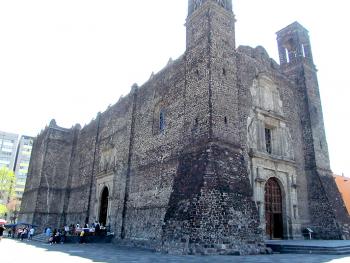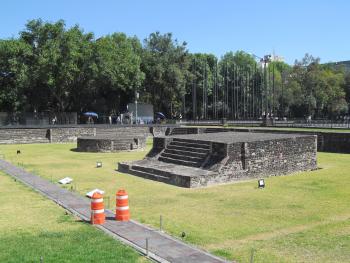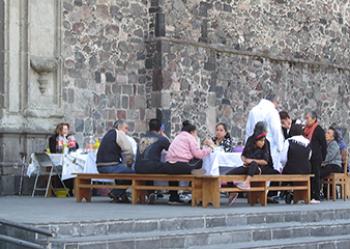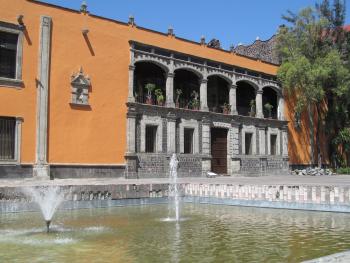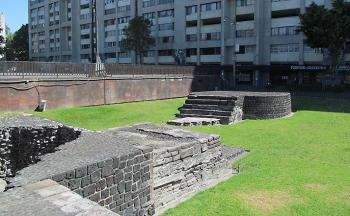Mexico City - Plaza of the Three Cultures
This item appears on page 26 of the July 2021 issue.
There are some places we visit that capture our minds and hearts for a long time afterward. Sometimes forever. For me, Mexico City is one of those places. It has been since I first visited more than 40 years ago.
Mexico City is everything I look for in a destination: lovely accommodations in all price categories, wonderful cafés and restaurants, lots of museums and sights, archaeological sites, artists’ markets and green spaces plus the less tangible but necessary vibrancy and color. It’s why I keep going back.
In the midst of all there is to see and do, there is one relatively modest site I return to on almost every trip. It’s the Plaza de las Tres Culturas (Plaza of the Three Cultures) — certainly not one of Mexico City’s most spectacular sights and not even one that some travel books label a “must see” for tourists.
But it is special to me because it is one of the places I visited on my first trip to Mexico City and because of its unique historical significance.
The plaza
Located in the Tlatelolco neighborhood of the city and about 2 miles north of the Zócalo, Mexico City’s chaotic main square bordered by three of the city’s major sights — the Metropolitan Cathedral, the National Palace and the Templo Mayor — the Plaza of the Three Cultures (phone +52 55 5583 0295, www.tlatelolco.inah.gob.mx) offers a quick synopsis of this city’s history.
In a relatively small area centered on this plaza, three periods of Mexico City’s history come together, all companionably located alongside each other: the pre-Columbian Aztec city of Tlatelolco, a Spanish-era colonial church and monastery, and present-day Mexico City.
Aztec city
The ancient Aztec city of Tenochtitlán now lies beneath the streets of the oldest part of Mexico City in the vicinity of the Zócalo. According to some archaeologists, its neighbor Tlatelolco may have been an independent Aztec city-state founded several centuries before Tenochtitlán. Other archaeologists believe that Tlatelolco was actually founded in the 14th century AD by Tenochtitlán Aztecs who broke away to establish nearby Tlatelolco.
In any case, Tlatelolco grew to become an important market, one of the largest in Mexico, supplying its dominant neighbor, Tenochtitlán, with food and other goods. About 1473, however, Tlatelolco was absorbed into Tenochtitlán.
Forty-six years later, Hernán Cortés with his band of Spanish conquistadores arrived in the Valley of Mexico, where both Tlatelolco and Tenochtitlán were located. He defeated Cuauhtémoc, the Aztec successor to Moctezuma II, in battle in August 1521. The last battles were fought in Tlatelolco, sounding the death knell to the Aztec empire.
Tour among the ruins
Passing a circular temple dedicated to Ehécatl, god of wind and air, and the Calendar Temple with glyphs (pictographs) representing the Aztec calendar, one comes to a palace with small rooms surrounding a courtyard.
Just across from these structures lies the Great Temple, a twin pyramid with dual staircases similar to the Templo Mayor off the Zócalo. One staircase once led to a temple dedicated to Tláloc, the Aztec god of rain and water, while the other climbed to the temple of the sun and war god, Huitzilopochtli.
Remnants of other stairways stand in front of these two staircases, evidence of the layers of pyramid, one atop each previous one, as the pyramid grew in size.
An example of a huge pyramid base that once supported a pyramid, or pyramids, and temples on top lies on the far side of the Great Pyramid. Behind this platform is a tzompantli, a rack that held the decapitated skulls of defeated enemies.
Literally littering the archaeological site are other platforms, pyramid bases, staircases and altars.
Spanish-colonial church
The conquering Spaniards were quick to consolidate their victory. By 1536, they had established the Colegio de la Santa Cruz de Tlatelolco (College of the Holy Cross of Tlatelolco), considered the oldest European school in the New World, where boys from the Aztec ruling class were educated.
Even earlier, around 1527, a church, Templo de Santiago, dedicated to St. James, Spain’s patron saint, was built steps away from the Great Temple. This earliest church was replaced about 1610 by the fortress-like structure with the two bell towers you see there today. Much of the stone used to build the church came from the ruins that lie surrounding the church, including the Great Temple.
Step inside the church to see its simple interior and the dome encircled by the four Evangelists — Matthew, Mark, Luke and John — together with their symbols. To the right of the main western church entrance stands the large apricot-colored stone monastery that was once part of the church complex.
On the Sunday my husband, Paul, and I visited in February 2019, a large wooden table had been set up in front of the church’s west façade and covered with a white cloth. Parishioners had loaded the table with food for a late-morning brunch. There were also a few small booths scattered nearby selling inexpensive toys, balloons and candy clearly intended for neighborhood children.
Nonoalco
The last of the triumvirate of sights in the Plaza of the Three Cultures is the immense complex of buildings surrounding the pre-Columbian ruins and the colonial-era church and monastery. It’s known as Nonoalco, a huge conglomerate of apartment buildings incorporating stores and schools that was built in the 1960s by architect Mario Pani. The complex has not worn well over the past 60 years.
Unfortunately, more recent history has not treated this area well either. In October 1968, the Plaza of the Three Cultures was the scene of students and activists protesting the 1968 Mexico City Olympics. Military troops fired on a crowd, killing several hundred people, it is estimated.
Then, in September 1985, the earthquake that killed thousands in Mexico City also brought about the collapse of some of the Nonoalco buildings, again killing hundreds.
When strolling there on a peaceful Sunday, it’s difficult to visualize how much tragedy has occurred in that one space. Children ride their bicycles, and couples stroll among the ghosts of the past.
If you go…
The Tlatelolco archaeological area is presently closed to visitors because of the pandemic. When it reopens, the hours will probably be daily from 8 to 6, with free admission. It’s best to check before you go. However, you can see almost all of the archaeological complex without entering the zone itself.
The Templo de Santiago is open to visitors whenever services are held.
The easiest, quickest and best way to reach Tlatelolco is by cab, a relatively inexpensive way to travel there and around most of Mexico City.

